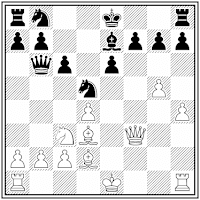10...Bd6 was covered earlier and provides black only limited chances for equality, provided white chooses the right continuation 11.Ne4, and refrains from the natural 11.00
Black's main line 10...Be7 is followed by 11.h4 ( note that Scheerer gives 11.00 as the main line, without even mentioning 11.h4. Scheerer's continuation 11.00 00 12.Qe4 g6 13.h4 leads to disaster after both 13...c5 and 13...Qd6 - so once again, please dont follow the big books blindly !! )
a/ 11...00 looses immediately after 12.Qe4 g6 13.h5
a1/ 13...Bxg5 14.hxg6
a11/ 14...Bxc1 15.g7 !! Nf6 16.Qg2 winning
a12/ 14...hxg6 15.Qe5 !! winning
a2/ 13...Nxc3 14.bxc3 Qd5 15.Qh4 winning
a3/ 13...Nb4 14.hxg6 Nxd3 15.cxd3 winning
a4/ 13...Qe8 14.Qh4 f5 15.gxf6 winning
a5/ 13...Qc7 14.Qh4 winning
b/ 11...Nxc3 12.bxc3 only strengthens white d4 pawn
b1/ 12...00 13.Qe4 lines up the same idea as above
b2/ 12...Nd7 13.00 00 14.Rb1 with an equal position
b3/ 12...Qd5 13.Be4 Qc4 14.Rb1 b6 15.Rb3 with a small white advantage
b4/ 12...Qc7 13.00 00 14.Rb1 with a small white advantage
b5/ 12...Qb6 13.00 00 14.Qe4 g6 15.h5 with a small white advantage
d/ 11...Nb4 12.Bf4
d1/ 12...Nxd3+ 13.Qxd3 equal
d2/ 12...Qxd4 13.000 with small white advantage
d3/ 12...Qa5 13.a3 equal
d4/ 12...Na6 13.Be4 equal
e/ 11...Qb6 12.Bd2
e1/ 12...Qxd4 13.Nxd5 Qxd5 14.Be4 Qc4 15.000 equal - white has a tremendous developm,ent and space advantage for the two sacrificed pawns
e2/ 12...Nd7 13.Nxd5 equal ( probably better than 13.Ne2 that I recommended in my book )
e3/ 12...00 13.Qe4 g6 14.h5 and white is clearly winning
e4/ 12...Qxb2 13.Rb1 Qa3 14.00 and white is better
e5/ 12...Nxc3 13.Bxc3 and a tiny white advantage
f/ 11...Qc7 12.Bd2
f1/ 12...Nd7 13.000 and a small white advantage
f2/ 12...Na6 13.Nxd5 and white is better
f3/ 12...Nxc3 13.Bxc3 and white is better
f4/ 12...00 13.000 and white is better
g/ 11...Qa5 12.Bd2
g1/ 12...Nxc3 13.Bxc3 Bb4 14.Bxb4 Qxb4 15.c3 and white is better
g2/ 12...Nd7 13.Ne2 and white is better
g3/ 12...Bb4 13.a3 Bxc3 14.bxc3 and white is clearly better
g4/ 12...00 13.Qe4 ( better than 13.a3 as recommended in my book ) g6 14.h5 Nxc3 15.bxc3 with a large white advantage
So let's look back and consider black's chances. Black is a pawn ahead in all lines, but his position remains underdeveloped, crampled by the advanced h4 and g5 pawns. White will simply castle queenside and must wait untill black makes a mistake.
After black castling kingside, white's thematic attack Qe4 followed by h5 is exceptionally strong and sufficient for the win.
Summary, black can obtain equality in the main Teichmann Exchange lines ( 1.d4 d5 2.e4 dxe4 3.Nc3 Nf6 4.f3 exf3 5.Nxf3 Bg4 6.h3 Bxf3 7.Qxf3 c6 8.g4 e6 9.g5 Nd5 10.Bd3 Be7 11.h4 ), but it is an uphill struggle and provides no room for a black win against accurate white play.







No comments:
Post a Comment